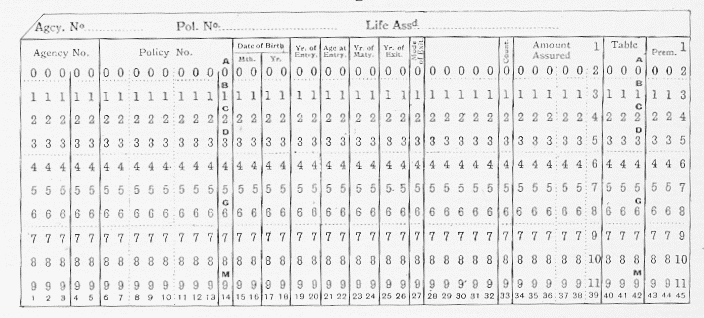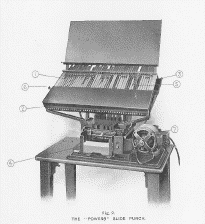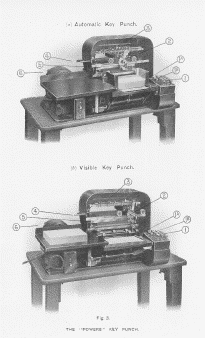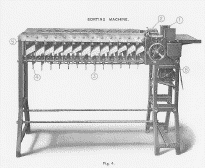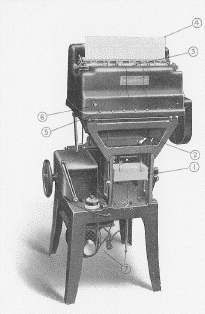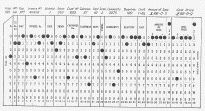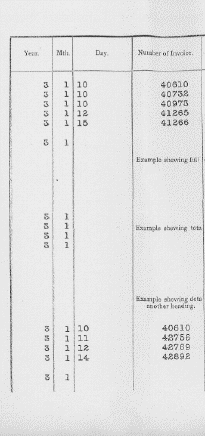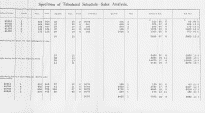|
The Powers Tabulating System
The Accounting and Tabulating
Contractors to H.M. Government.
57-58, CHANCERY LANE Hazell, Watson & Viney, Ld., Printers, London and Aylesbuy. 12716-20. (Brochure is ca. 1913)
The "Powers" Tabulating System By THE " POWERS " system stereotyped, clerical work is very largely reduced or abolished and more accurate results are obtained in a shorter time. Employers receive valuable data and information hitherto considered unattainable on account of the enormous amount of clerical labour and expense involved. The information which has been furnished to employers in the past has often only represented the opinion of someone. "POWERS" machines have no opinions: they register the actual facts, and can only supply results that are shown by the facts. THE "POWERS" system of mechanical accounting and tabulating is used by Government Departments, Railways, Banks, Insurance Companies, Manufacturers, and other business companies in connection with accounts of all kinds, statistical work, costs and sales analysis, pay roll calculations and other similar work. ( 3 ) |
||||||||||||||||||||||||||||||||||||||||||||||||||||||||||||||||||||||||||||||||||||||||||||||||||||||||||||||||||||||||||||||||||||||||||||||||||||||||||||||||||
|
T he" POWERS " system consists of the following :(1.) The Automatic Punching Machine (Figs. 2 and 3), which is used to produce records on specially designed cards. The cards (Fig. 1) contain 45 columns and are divided into fields, with headings corresponding to the facts which it is desired to record. In each of such fields holes are punched, by means of a key-board, to indicate department, article, quantity, value or other description of facts. THE PUNCHING MACHINE is so constructed that the cards are fed into the machine and ejected automatically, and the Operator's attention is simply confined to translating the original record on to the cards. The punching of the cards replaces the entering of the same facts in books or cards by hand, and can be carried out more rapidly-just as the typewriter is quicker than the pen. Identical information (for the whole or part of the card) can be repeated automatically on any number of cards without resetting the keys of the punching machine. Owing to this feature a speed of over 1,000 cards per hour has been attained on Insurance Company work. The type of punch to be selected will depend on the class of work to be performed. The key-punch (Fig. 3) is specially applicable where the original information is entered on the cards and holes are punched on the same card for analytical and statistical purposes. (2.) The Automatic Sorting Machine (Fig. 4) sorts the cards at the rate of 18,000 per hour. The sorter enables the information to be grouped and re-grouped in any form desired. A counting device can be attached to ( 4 )
this machine, consisting of 12 individual counters corresponding to the 12 possible holes in a column, a sub-total counter and a grand total counter. By the " POWERS " system incorrect sorting is eliminated as a perfect check is afforded. By holding the cards to the light it can at once be seen that the same holes have been punched in every card in the sorted group. (3.) The Tabulator Printer (Fig. 5) translates the holes in the card back into ordinary writing, and at the same time adds those fields representing weights, values, wages, premiums, etc., the totals being printed at the foot of each tabulation. Where totals only of groups of cards are required, without the tabulated details, a button eliminates the listing feature, and one total after another is recorded automatically without stopping the machine. The designation of each group is also printed against its corresponding total (see tabulated sheet). Carbon copies can be obtained, thus ensuring the correctness of each copy if more than one should be necessary. The speed of operation of these machines is 3,500 cards per hour, with a fully printed permanent record of each card and as many totals as required. The adaptability of the "POWERS" system to all forms of accounting and statistical work and particularly to work necessitating intricate analysis will at once be recognised. The opportunity is offered for securing increased efficiency and economy by the substitution of automatic, mechanical and printing methods for hand written books and records. Each type of "POWERS" machine is easily operated by young girls or boys after a few hours' tuition. The machines ate installed and maintained by the Corporation. ( 5 ) |
||||||||||||||||||||||||||||||||||||||||||||||||||||||||||||||||||||||||||||||||||||||||||||||||||||||||||||||||||||||||||||||||||||||||||||||||||||||||||||||||||
|
The ACCOUNTING and TABULATING CORPORATION undertakes all kinds of statistical work for firms whose business does not justify the full use of a " POWERS" installation and also for users of the machines who are faced with a temporary pressure of work. A staff of skilled operators is employed under the supervision of experienced statisticians, and, wherever possible, assistance will be given in adapting the system to particular requirements,
For further particulars apply to the Offices of the Corporation : 57 & 58, CHANCERY LANE, LONDON, W.C,2.
SPECIMEN CARD.
(6)
Examples of Cards in use, illustrating some of the most frequent applications of the "POWERS" System.
These examples are merely illustrative. The card is designed to suit each particular case. The machines are universal, and most clients use many different cards on the same machines. ( 7 )
|
||||||||||||||||||||||||||||||||||||||||||||||||||||||||||||||||||||||||||||||||||||||||||||||||||||||||||||||||||||||||||||||||||||||||||||||||||||||||||||||||||
|
SLIDE PUNCH. ( I) Keyboard composed of 45 key bars, each having 12 notches numbered "0" to "12." These keys are in colours-white, black, red, and blue-arranged to correspond with the vertical columns on the cards to be punched. For example, if six columns represent a money field, white would be used for the £'s' black for the shillings, and red for the pence.The information is set up by the use of both hands, the fingers being placed on the numbers desired and pulled down to the top of the hand rest plate. (2) Forty-five Correction Keys which, when pressed, allow the key slide to return to the normal position. Any wrong setting, therefore, can be corrected before punching as no punching takes place until the whole of the numbers have been set on the machine. (3) Punching lever which when depressed causes all the figures which have been set-and which are then seen .just above the hand rest plate-to be punched into the card at one and the same time, thus ensuring the perfect registration of the holes. (4) Receiving box into which the card is ejected immediately on being punched. At the same time as the card is ejected an unperforated card is drawn into position from a similar receptacle at the back of the machine. (5) Forty'-five Gang Stops which can be set in any position on the Keyboard and thus prevent the key slide from returning to the top of the machine. All information constant over a series of cards can thus remain on the machine without further attention from the operator. Similarly, all ciphers are automatically recorded; e.g., the setting of £5,000 involves the pulling down of one slide to the figure " 5." (6) Repeat Key which, when depressed, retains the whole of the setting on the machine and thus enables cards to be punched in duplicate, triplicate, &c. (7) Small 1/8 H.P. Motor which operates the machine. ( 8 ) (9) |
||||||||||||||||||||||||||||||||||||||||||||||||||||||||||||||||||||||||||||||||||||||||||||||||||||||||||||||||||||||||||||||||||||||||||||||||||||||||||||||||||
|
KEY PUNCHES. Key Punches are of two types (a) Automatic feeding attachment, (b) Visible feeding attachment (a) would be used if cards were being punched from information provided on schedules or in books, &c. ; (b) would be used when the original information is recorded on the card to be perforated. This feature is one which will, undoubtedly, be developed to a considerable extent in the future. (1) Fourteen Keys, 12 of which are numbered, the remaining two being (IA) the Skip Key, (1B) the Punching Key. The information is set up by tapping the keys in the same way as a typewriter is operated. The tapping of a wrong key is rectified by tapping the right key. (2) This carriage travels along column by column after each figure has been set. As in the case of the Slide Punch, no punching takes place until after the information has been set up and the Punching Key has been depressed. (3) These Skips, when used in conjunction with (IA), allow the carriage to jump over any number of columns. (4) Adjustable Stop governing the commencing column for punching. (5) Forty-five Gang Stops which allow information which is constant to a group of cards to remain set on the machine. No repeat key is necessary on a Key Punch as the punches remain set until the carriage is restored to the initial punching column. (6) Small 1/8 H.P. Motor which operates the machine. ( 10) (a) Automatic Key Punch Fig. 3 The "POWERS" KEY PUNCH. (11)
|
||||||||||||||||||||||||||||||||||||||||||||||||||||||||||||||||||||||||||||||||||||||||||||||||||||||||||||||||||||||||||||||||||||||||||||||||||||||||||||||||||
|
SORTER.
( 1) Card Feeding Box in which the cards are continuously placed.
(2) Twelve Selector Pins under which each card passes at a minimum speed of 250 per minute. The pin which passes through the hole in the card selects the receiving box into which the card falls.
(3) Receiving Boxes, one for each of the twelve possible holes in the vertical column of a card.
(4) The thirteenth receiving box which collects all cards which have no hole punched in the column that is being sorted.
(5) Counters can be attached, one to each box, to record the number of eards falling into the same. Similarly, grand total and Su1b-total counters can be attached to show the total number of cards passing through the machine.
(6) Small 1/8 H.P. Motor operating the machine and which automatically eases to run when the last card has been sorted.
( 12 ) (13)
|
||||||||||||||||||||||||||||||||||||||||||||||||||||||||||||||||||||||||||||||||||||||||||||||||||||||||||||||||||||||||||||||||||||||||||||||||||||||||||||||||||
|
TABULATOR.
(1) Card plate on which the cards are ejected one by one as they pass through the machine. A card feed box, similar to that on the Sorter, is at the back of the Tabulator.
(2) Connection Box containing the wires (arranged according to requirements), which are operated by the pins which pass through the holes of each card.
(3) An assembly of 4, 5, 6 or 7 separate adding machines, each consisting of nine banks, which are operated by the card itself.
(4) Schedule on which the printed details are recorded. The schedule moves up one space after each card has recorded its details. Four and five carbon copies of the results can be obtained. A roll of paper can also be used.
(5) Stop attached to each adding unit which allows it to be used for designating or totaling, according as the stop is out or in.
(6) Stop which, when in, causes the details of each card to be printed as well as the totals. When this stop is out the machine prints totals only, at the same time recording the designation of the group to which the totals refer
(7) One-quarter H.P. Motor driving machine which automatically stops after last card has passed through.
( 14 )
Fig. 5. THE "POWERS" TABULATOR. ( 1 5 )
|
||||||||||||||||||||||||||||||||||||||||||||||||||||||||||||||||||||||||||||||||||||||||||||||||||||||||||||||||||||||||||||||||||||||||||||||||||||||||||||||||||
|
Powers Sample Card |
||||||||||||||||||||||||||||||||||||||||||||||||||||||||||||||||||||||||||||||||||||||||||||||||||||||||||||||||||||||||||||||||||||||||||||||||||||||||||||||||||
|
Sample Powers Tabulator printout in two sections as it would not fit on the scanner. |
||||||||||||||||||||||||||||||||||||||||||||||||||||||||||||||||||||||||||||||||||||||||||||||||||||||||||||||||||||||||||||||||||||||||||||||||||||||||||||||||||
